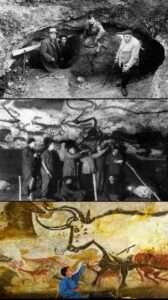On September 12, 1940, in the village of Montignac, Dordogne, France, four curious children made an extraordinary discovery. As they ventured into a hole in the forest, they tossed stones to gauge its depth before carefully descending into the narrow shaft. To their amazement, they uncovered a hidden cave that would later become known as the Lascaux cave.
Upon igniting a lamp, the children were astounded by the spectacular images that adorned the cave walls. Home to over 600 remarkable paintings, the Lascaux cave showcases artwork dating back 17,000 years, offering a glimpse into the world of Upper Paleolithic art. These intricate depictions feature a diverse array of animals, including horses, deer, bison, and mysterious creatures that may have been of mythical origin.

In 1948, the Lascaux cave was opened to the public, allowing visitors to marvel at the ancient masterpieces. However, due to the detrimental effects of artificial lighting, which caused the paintings’ vibrant colors to fade and moss to grow on the walls, the cave had to be closed in 1963 to preserve its integrity.
In response to the need for conservation, a replica of the cave was painstakingly created nearby in 1983. This replica enables visitors to continue experiencing the awe-inspiring artwork of the Lascaux cave while safeguarding the original site for future generations to appreciate.
The discovery of the Lascaux cave remains a testament to the ingenuity and artistry of our ancient ancestors, providing a window into a bygone era and captivating all who have the opportunity to witness its beauty firsthand.





